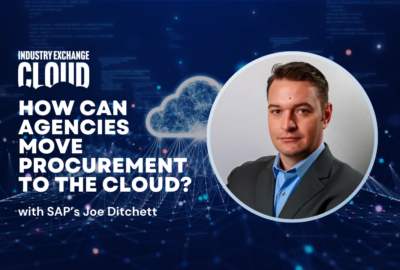Insight by SAIC
Artificial intelligence starts with a robust data policy
To ensure value out of artificial intelligence, first understand what AI actually is, versus a buzzword make popular by emergent generative applications. That�...
To ensure government agencies receive value from artificial intelligence, first you must understand what AI actually is, versus a buzzword made popular by emergent generative applications. That’s according to Jay Meil, chief data scientist and managing director for artificial intelligence at SAIC.
“The first thing I ask our customers in the federal government is, what are you trying to do? Because AI is really just a means to an end,” Meil said. Answering that is not a trivial matter. Too often, people say they want artificial intelligence because there’s some sort of AI mandate in place or because everyone else seems to be launching AI projects.
“You really have to dig into and understand what the customer’s mission is,” Meil said.
Still, many agencies do have a clear idea of what they want to accomplish. A common requirement, Meil said, coming from the defense, civilian, law enforcement and intelligence domains: how to create human-machine teams. That is, “look for different ways to ease the cognitive load on users, and to make informed decisions faster and better,” Meil said.
Data underlies the ability to create man-machine teaming, Meil said. It’s a matter of using algorithms to discern patterns or anomalies in amounts of data too large for people to parse.
“Humans and machines can both think, in different ways,” Meil said. “Machines think in a way that’s very good at processing numbers, very quickly; large amounts of data, pulling out signals in the noise, or hidden patterns in the haystack.” But they can’t do the logical reasoning that goes into strategic decision-making by people. In that sense, AI can augment people’s main strength and help them avoid analysis paralysis or, equally bad, not seeing important signals because of an overwhelming amount of data.
Therefore, to have success deploying AI, an organization needs to reach a high level of data maturity, Meil said. He outlined five sights” in a data maturity model.
Hindsight means you can use data to understand what happened.
Foresight, the next level up, enables predictive analytics, the ability to evaluate possible outcomes of future actions.
Insight is still higher, resulting in what Meil called prescriptive analytics. “It’s if I know that I could have outcome A, B, or C with a given level of confidence, what can I do to drive towards one of those potential outcomes?”
Oversight and right-sight make up the highest level of data maturity, Meil said.
“Oversight is the ability to see everything in a common picture, all of your analytics in one place on one dashboard.” Meil describes right-sight as individual, deep learning into patterns or anomalies revealed by the oversight function, to help decision-making.
Verification and feedback
In getting to a state of good data maturity, Meil said, organizations tend to focus on “what the data looks like when we bring it in, how we shape it, what the model looks like and what the results are.”
But, he said, it’s also important to pay attention to what he called verification and feedback, once an AI program generates a result.
“We take it a step further and say, is that what we were expecting? Is that what the model should have inferenced? Is that the answer that should have been given?” That post-facto analysis feeds into ongoing training of the algorithm, Meil said, “so the models get smarter over time.”
He added, you don’t always need huge data sets to properly train AI programs. Having the right data is more important, or using synthetic data that might result in more accurate, less biased outcomes.
Also important: what Meil called pre-processing pipelines to convert non-machine-readable data that might be important, such as contained in PDFs, PowerPoint presentations or SharePoint documents. AI programs ultimately need data formatted in such a way that the algorithm can process it.
Meil said building high-impact AI applications in which the organization can have confidence depends on a robust data strategy and transparency, and “understanding how the machines are making the decisions they’re making.” He termed that second criterion, responsible artificial intelligence.
He noted that SAIC’s low-code, no-code orchestration tool for AI, called Tenjin, is “designed very deliberately to give our customers the power to do data science.” AI, he said, is complicated, and most agencies lack the number of data scientists they need. Data scientists often lack domain or mission expertise, so giving people throughout the agency some data science skills, via a tool set like Tenjin, can speed the deployment of responsible projects, Meil said.
“It empowers them, the analyst, the operator, the warfighter, the law enforcement officer, the diplomat, any enterprise user,” Meil said, “to be able to interact with data in a fundamentally different way. It creates self-service analytics.”
For further insights on artificial intelligence at SAIC, go to saic.com/ai.
Listen to the full show:
Copyright © 2024 Federal News Network. All rights reserved. This website is not intended for users located within the European Economic Area.
Related Stories
Protected: Industry Exchange Cloud 2024: SAP’s Joe Ditchett on how agencies can move procurement to the cloud
VA approach to automated software testing is rooted in flexibility and efficiency
Featured speakers
-

Jay Meil
Chief Data Scientist and Managing Director for Artificial Intelligence, SAIC
-

Tom Temin
Host, The Federal Drive, Federal News Network
Upcoming Events
Related Stories
Top Stories

Jay Meil
Chief Data Scientist and Managing Director for Artificial Intelligence, SAIC
Jason “Jay” Meil is the director of data science and chief data scientist for SAIC’s Artificial Intelligence (AI) Innovation Factory, where he leads AI technical strategy and solutions that enable rapid decision-making at scale in support of multiple intelligence disciplines.
With two decades of experience in applied mathematics, data science and deep learning, Meil is a recognized expert in analytical tradecraft,, all source intelligence and open source intelligence. He serves as a technical advisor to numerous intelligence organizations within the Intelligence Community (IC) and Department of Defense (DOD), applying his tradecraft to the domains of intelligence, surveillance and reconnaissance; targeting; and algorithmic warfare.
Meil has led cross-functional teams in designing, building and deploying deep learning models to support federal government customers in complex missions of national importance, with the ultimate objective of making the nation safe against peer and near-pear threats. In addition to IC and DOD customers, he has supported civilian agencies including the Department of Homeland Security.
As an SAIC research fellow, Meil has focused on two areas:
• integrating multi-modal intelligent decision support systems into command and control operations
• offensive and defensive AI algorithms in identity intelligence, information warfare, information operations and unconventional warfare (I2/IW/IO/UW) operations.
Meil is a frequent participant in research panels and industry discussions on the impact of AI on national security, including with the John Hopkins University Applied Physics Laboratory; the Center for Security in Politics at UC-Berkeley on behalf of DARPA; CERN’s OpenLab and Quantum Technology Initiative; the European Geosciences Union; the Atlantic Council Scowcroft Center for Strategy and Security; the Potomac Officers Club; and AFCEA.

Tom Temin
Host, The Federal Drive, Federal News Network
Tom Temin has been the host of the Federal Drive since 2006 and has been reporting on technology markets for more than 30 years. Prior to joining Federal News Network, Tom was a long-serving editor-in-chief of Government Computer News and Washington Technology magazines. Tom also contributes a regular column on government information technology.






